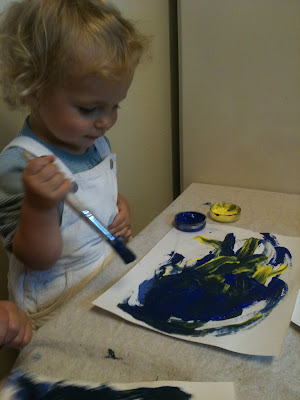3. Tempera Paint, Paper, Hands:
After
the toddlers spent a few days experimenting with color mixing using
watercolors, I brought out the tempera paint. At first, I set out a
large sheet of white paper on a canvas in the front yard. I poured
some white paint and red paint in different areas on the paper. M
helped find rocks to put on the paper to keep it from moving. My only
comments to T, M, J, and S were that they could use
their hands with the paint and I posed the question, “I wonder what
happens when red and white paint mix together?”

M, T, and S all immediately began touching the paint with their hands. M and S used their fingertips first to gently rub the paint around, while T used the palm of her hand to rub a few drops of red paint together with a circle of white paint. J watched, wanting to just observe the paint exploration this time around.



When the girls were nearly done exploring the red and white paint, each of them turned their hands over to observe the paint that was on the bottom of them. I asked everyone, "I wonder what you noticed when red and white paint mixed together?" M quickly commented, "it's pink," as she looked intensely at the palms of her hands.
When everyone was finished painting, we looked at our large piece of paper and discussed how there were different shades of pink on the paper. M noticed how there was "light pink" and "dark pink." We talked about how different amounts of each paint cause the slight color changes.
4. Tempera Paint, Construction paper, Paintbrushes:

Our final color mixing exploration with tempera paint included yellow and blue paint on white construction paper. There was a paintbrush available for each child to use. T, M, and S immediately picked up their paintbrushes and began dipping them in the paint and placing the paint on their papers. J observed his paint for a short while, then joined in on the painting.


After a few minutes, M began rubbing the palm of her hand around on the paint, mixing the yellow and blue paint together as she smoothed all the lumps out. She said, "This is the sun." Then pointing to the top of her painting, she said, "This is the ocean." T looked at her painting and again said, "The sun." She then pointed at it and said, "Two suns. Three suns." Jacob placed his fingertips on his painting and then showed his blue fingers to me excitedly.

When T, M, and J were finished painting, they rinsed out
their paintbrushes and plastic lids in a bucket filled with water and a
small amount of soap. S continued to paint. She painted for another 5-10
minutes while T, M, and J played in the classroom. As she added more
blue to the mostly yellow paint on her paper, she pointed at the lid
filled with blue paint and exclaimed, "Blue!" Soon, it was time for
snack and S quickly finished painting and rinsed out her paintbrush and
lids.
Throughout the color mixing exploration with watercolors and tempera paint, I noticed a few things. T, M, J, and S know quite a few colors between them and by exploring paint through color mixing, they are getting more exposure to colors and the properties of different colors of paint when mixed together. I noticed that each child found a different way to explore the various color mixing experiments, whether making different brush strokes, or dipping the end of the dropper in the water, then squeezing the bulb of the dropper to disperse the watercolor. Even when they just used their hands, fingertips were used, whole palms were used, only one hand was used, and both hands were used. These differences allow for a unique experience for each child to be an individual and explore their creativity in their own way. We also worked together as a group, talking about the paint, about the colors of the paint, about the paper being used, about the water and the watercolor, and about color mixing. These shared discussions brought us together as a cohort, sharing thoughts, asking questions, and observing each other's work.









Comments
Post a Comment